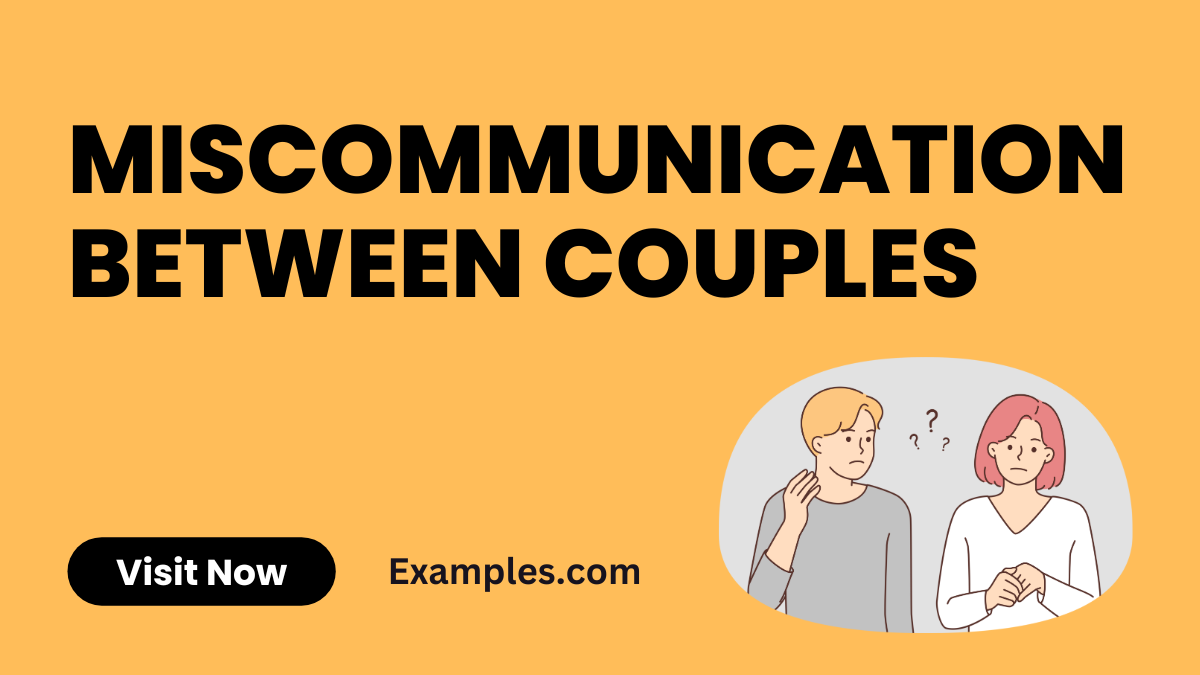19+ Miscommunication Between Couples Examples
Embark on a journey through the intricacies of relationships with our comprehensive guide on Miscommunication Between Couples. Delve into relatable Communication Examples that illuminate common pitfalls. Navigate the nuances of couple dynamics as we provide insights, actionable tips, and real-life scenarios to foster clearer connections. Enhance your understanding of miscommunication to strengthen your relationship foundation and promote effective communication for lasting harmony.
What is Miscommunication Between Couples?
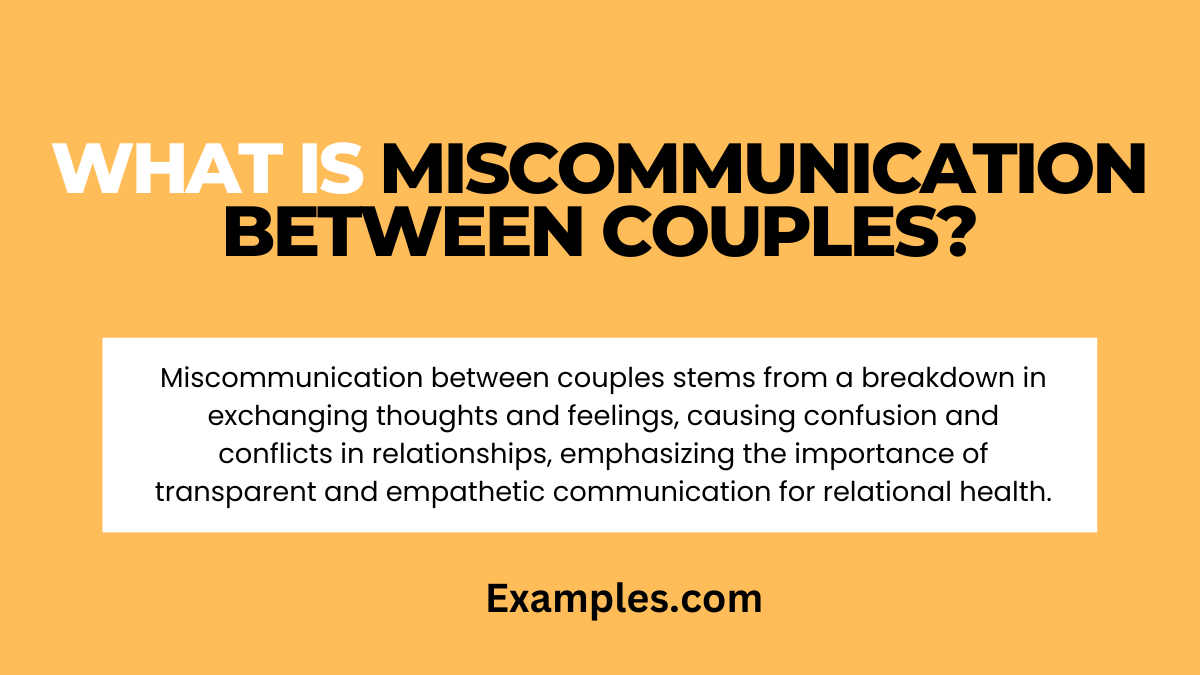
Miscommunication between couples refers to the breakdown in clear and effective exchange of thoughts, feelings, or intentions, leading to misunderstandings. In simple terms, it’s the unintentional gaps in understanding within a romantic relationship that result in confusion, conflicts, or emotional disconnection. This phenomenon can arise from different communication styles, unexpressed expectations, or misconstrued signals, highlighting the need for transparent and empathetic communication to nurture healthy and thriving relationships.
What is the Best Example of Miscommunication Between Couples?
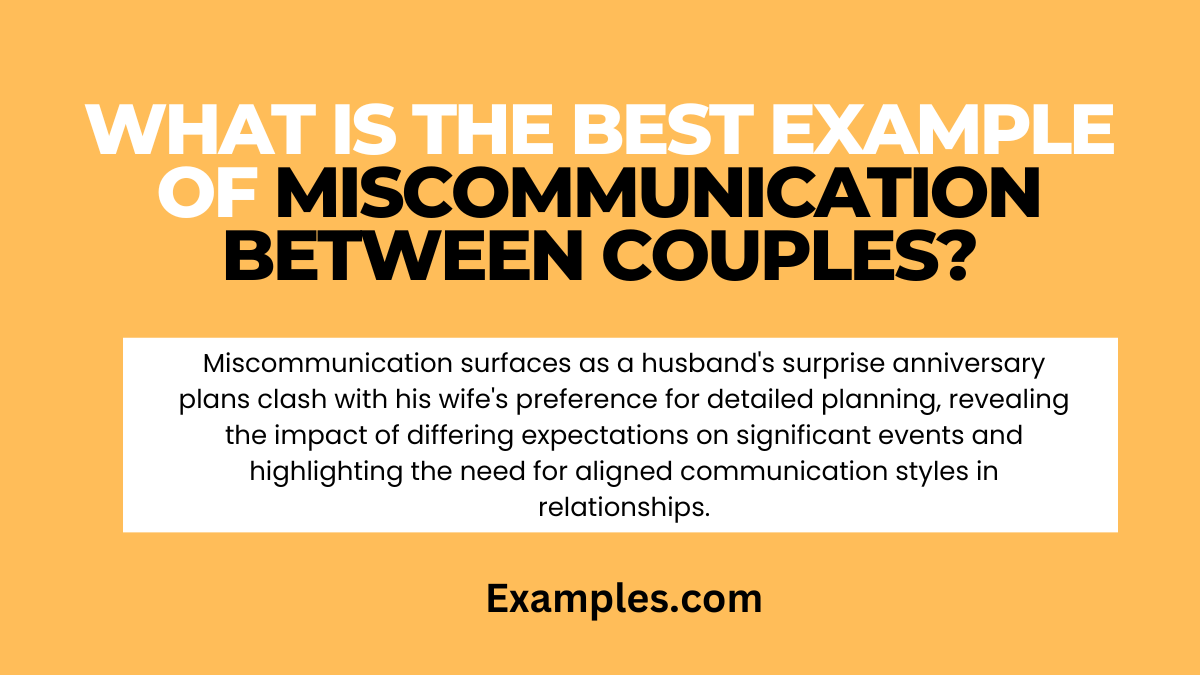
In this scenario, a husband plans a surprise anniversary celebration, assuming his wife enjoys spontaneous gestures. However, the wife values detailed planning and open communication about special occasions. The husband’s well-intentioned surprise clashes with the wife’s expectation for involvement in planning, leading to disappointment and a strained celebration. This example underscores how miscommunication about preferences can impact the emotional resonance of significant events, emphasizing the importance of aligning communication styles within relationships.
20 Miscommunication Between Couples Examples
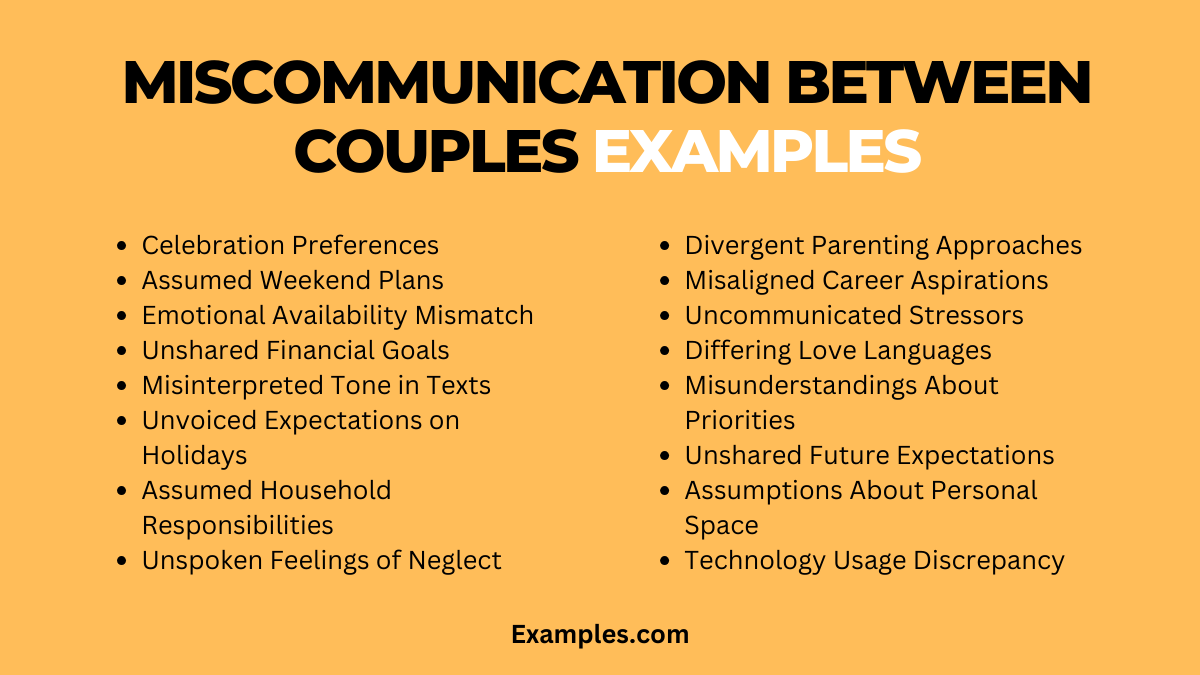
Explore our guide featuring vivid Miscommunication Between Couples Examples, offering valuable insights into common pitfalls and solutions for nurturing healthier relationships. Each scenario provides a unique lens into the intricacies of couple dynamics, facilitating a deeper understanding of communication challenges.
- Celebration Preferences Clash: Misunderstanding arises when one prefers surprises while the other values collaborative planning; communicate preferences for future celebrations.
- Assumed Weekend Plans: Disappointment ensues when assumptions about weekend plans differ; establish a habit of discussing expectations to align schedules.
- Emotional Availability Mismatch: Miscommunication occurs when one seeks comfort and the other needs space; openly express emotional needs to foster connection.
- Unshared Financial Goals: Conflicts arise when financial goals are not communicated; initiate a conversation about long-term financial plans for mutual understanding.
- Misinterpreted Tone in Texts: Disagreements stem from misinterpreting text messages; clarify intentions and tones for smoother digital communication.
- Unvoiced Expectations on Holidays: Frustration arises when expectations for holiday traditions differ; discuss and align expectations for a harmonious celebration.
- Assumed Household Responsibilities: Tensions emerge when assumptions about household responsibilities clash; openly communicate and delegate tasks for shared accountability.
- Unspoken Feelings of Neglect: Misunderstandings arise from unexpressed feelings of neglect; foster open communication to address and alleviate emotional concerns.
- Divergent Parenting Approaches: Conflicts arise when parenting approaches differ; engage in open discussions to establish a unified strategy for effective co-parenting.
- Misaligned Career Aspirations: Strain occurs when career aspirations are not communicated; share individual goals to build a shared vision for the future.
- Uncommunicated Stressors: Tension builds when stressors go uncommunicated; establish a safe space for discussing individual stressors and supporting each other.
- Differing Love Languages: Conflict arises when love languages are misunderstood; identify and express love preferences for more meaningful connections.
- Misunderstandings About Priorities: Disagreements stem from differing priorities; engage in regular discussions to align values and adjust priorities as a team.
- Unshared Future Expectations: Conflict emerges when future expectations are not communicated; openly discuss long-term goals to ensure alignment.
- Assumptions About Personal Space: Friction occurs when assumptions about personal space differ; express needs for alone time to maintain a healthy balance.
- Technology Usage Discrepancy: Disconnection arises from mismatched views on technology use; establish boundaries and expectations for screen time to foster connection.
- Miscommunication About Intimacy: Issues arise when intimacy expectations are not communicated; discuss desires and boundaries to enhance physical connection.
- Discrepancy in Apology Styles: Conflict ensues when apology styles differ; understand each other’s preferred apology languages for effective resolution.
- Assumed Preferences in Leisure Activities: Disappointment occurs when leisure preferences are assumed; communicate interests to plan enjoyable activities together.
- Unvoiced Personal Growth Goals: Strain arises when personal growth goals are uncommunicated; share aspirations for individual growth to support each other’s journeys.
Explore these additional examples for a comprehensive understanding of miscommunication challenges and strategies to strengthen your relationship through effective communication.
Miscommunication Between Couples for Dating Examples
Uncover the nuances of dating dynamics with our guide on Miscommunication Between Couples for Dating. Explore real-life scenarios, gain insights into common pitfalls, and discover effective communication strategies for fostering stronger connections during the dating phase.
- Mixed Signals About Exclusive Dating: Navigating exclusivity misunderstandings; initiate a direct conversation to clarify relationship expectations and define exclusivity.
- Varying Expectations for Date Nights: Differing preferences for date night activities; discuss and plan activities that align with both partners’ interests for a mutually enjoyable experience.
- Assumed Next Steps in the Relationship: Misalignment in expectations about relationship progression; openly communicate desires and discuss future steps for mutual understanding.
- Communication Frequency Discrepancy: Friction arising from differing communication frequency preferences; establish communication expectations and boundaries for a harmonious connection.
- Misunderstandings About Gift Exchanges: Conflicts arising from mismatched expectations about gift-giving; openly communicate preferences and establish guidelines for thoughtful exchanges.
Continue exploring dating-specific miscommunication scenarios to navigate challenges and build a solid foundation for a thriving relationship.
Miscommunication Between Couples at Home Examples
Delve into the intricacies of home life with our guide on Miscommunication Between Couples at Home. Unearth real-life examples, gain insights into common domestic pitfalls, and discover effective communication strategies to maintain harmony within your shared living space.
- Discrepancies in Household Chores: Navigating tensions around chores; establish a clear division of responsibilities and openly communicate preferences for a balanced workload.
- Miscommunication About Alone Time Needs: Conflicts arising from unspoken needs for personal space; express the need for alone time and establish boundaries to respect each other’s space.
- Differing Meal Preferences and Planning: Friction over meal planning and preferences; engage in open discussions to create meal plans that cater to both partners’ tastes and preferences.
- Communication Gaps About Financial Decisions: Confusion surrounding financial decisions; establish regular financial check-ins and discuss budgetary plans to ensure shared financial goals.
- Assumed Leisure Time Activities: Mismatched assumptions about preferred leisure activities; communicate interests and plan activities that cater to both partners for an enjoyable time at home.
Explore these home-specific miscommunication scenarios to enhance communication skills and maintain a harmonious living environment.
How does miscommunication affect relationships between Couples?
Miscommunication within relationships can have profound impacts, often acting as a silent underminer of the very foundations that sustain a partnership. In this comprehensive guide, we unravel the intricacies of how miscommunication affects couples, offering insights, examples, and practical strategies for fostering healthier communication dynamics.
1. Understanding the Ripple Effect: Delve into the ripple effect of miscommunication, exploring how seemingly minor misunderstandings can escalate and impact various aspects of a relationship.
2. Navigating Emotional Disconnection: Uncover how miscommunication can lead to emotional disconnection, exploring the roots of emotional distance and strategies to bridge the gap.
3. Impact on Intimacy and Connection: Explore the nuanced ways miscommunication can hinder intimacy and connection, with practical tips on rekindling emotional and physical closeness.
4. Addressing Trust Erosion: Examine the erosion of trust resulting from miscommunication, understanding how trust issues manifest and strategies for rebuilding trust within a relationship.
5. Fostering Effective Communication: Delve into proactive approaches for fostering effective communication within couples, emphasizing the importance of active listening, empathy, and clarity.
6. Breaking the Cycle of Misunderstandings: Identify recurring patterns of miscommunication and learn strategies to break the cycle, promoting a more constructive and understanding dialogue.
7. Overcoming Assumptions and Expectations: Understand how assumptions and unmet expectations contribute to miscommunication, and gain insights into fostering open discussions to align expectations.
8. The Role of Non-Verbal Communication: Explore the often underestimated impact of non-verbal communication in miscommunication, with practical tips on decoding and improving non-verbal cues.
9. Navigating Differences in Communication Styles: Recognize the impact of differing communication styles and learn strategies to bridge gaps, fostering understanding and harmony.
10. Strengthening Resilience Through Communication: Conclude the guide by exploring how couples can build resilience through effective communication, promoting a stronger and more enduring relationship.
What are the ways to solve miscommunication between couples?
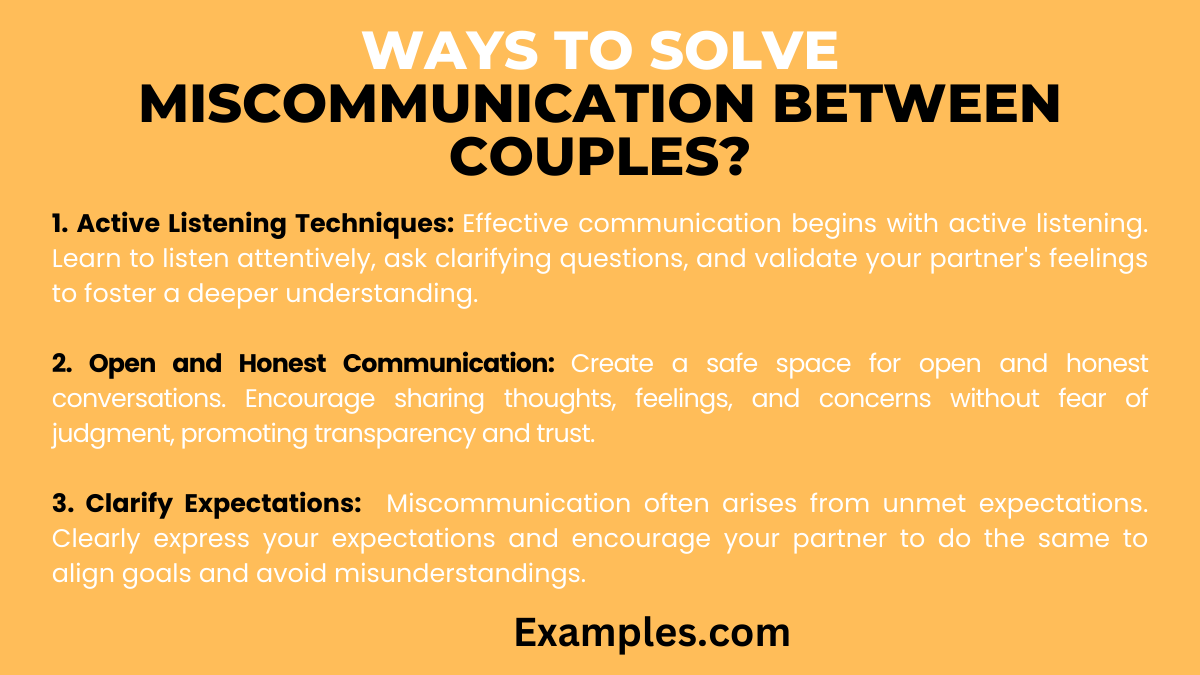
Miscommunication can be a common challenge in relationships, but understanding how to navigate and resolve it is crucial for building a strong connection. Explore the following strategies to address and overcome miscommunication between couples.
- Active Listening Techniques: Effective communication begins with active listening. Learn to listen attentively, ask clarifying questions, and validate your partner’s feelings to foster a deeper understanding.
- Open and Honest Communication: Create a safe space for open and honest conversations. Encourage sharing thoughts, feelings, and concerns without fear of judgment, promoting transparency and trust.
- Clarify Expectations: Miscommunication often arises from unmet expectations. Clearly express your expectations and encourage your partner to do the same to align goals and avoid misunderstandings.
- Use “I” Statements: Framing concerns using “I” statements instead of accusatory language can reduce defensiveness. For example, say, “I feel” instead of “You always.”
- Empathy Building: Cultivate empathy to understand your partner’s perspective. Acknowledge their feelings and experiences, fostering a connection that transcends miscommunication.
- Establish Clear Communication Channels: Define effective communication channels that work for both partners, whether it’s face-to-face discussions, text messages, or scheduled check-ins to maintain connection.
- Seek Professional Guidance: Consider couples therapy or counseling to navigate deeper communication challenges. A professional can provide guidance and tools for healthier communication.
- Reflect on Nonverbal Cues: Nonverbal communication plays a significant role. Pay attention to body language, facial expressions, and tone of voice to grasp the full message.
- Learn from Miscommunications: Treat miscommunications as opportunities for growth. Reflect on what went wrong and discuss ways to improve communication for future interactions.
- Practice Patience: Changing communication patterns takes time. Be patient with yourself and your partner as you work together to enhance your connection and understanding.
By implementing these strategies, couples can not only address miscommunication but also strengthen their communication skills, fostering a healthier and more resilient relationship.
In conclusion, navigating miscommunication between couples is a transformative journey towards stronger connections. By employing active listening, fostering open dialogue, and understanding each other’s perspectives, couples can transcend communication barriers. Embracing empathy and continuous learning from challenges paves the way for a resilient relationship, reinforcing the foundation of love and understanding.



